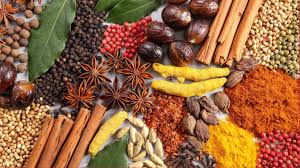
Spices Origins and Histories are more than just ingredients; they are storytellers of history, culture, and adventure. Here, we uncover the fascinating origins and global journeys of some iconic spices that have shaped cuisines and civilizations.
1. Cinnamon: The Ancient Luxury
- Origin: Native to Sri Lanka and Southern India, cinnamon has been valued for thousands of years. It was once so precious that it was considered a gift fit for royalty.
- Historical Significance: Ancient Egyptians used cinnamon in embalming rituals, while the Romans prized it for its ability to mask the smell of spoiled meat. During the Age of Exploration, it was a major driver of the spice trade.
- Fun Fact: In medieval Europe, cinnamon was more valuable than gold.
Cinnamon, known for its warm, sweet, and woody aroma, has been cherished for thousands of years. Native to Sri Lanka and southern India, this ancient spice Origins and Histories was once so rare and precious that it was considered a symbol of wealth and power.
A Spice Fit for Royalty
Cinnamon was mentioned in ancient texts, including the Bible, as a prized gift. In ancient Egypt, it was used in embalming rituals and as a fragrance for sacred ceremonies. The Romans valued it for its medicinal properties and as a luxury good, often adding it to wine and perfumes.
2. Black Pepper: The King of Spices
- Origin: Grown primarily on the Malabar Coast of India, black pepper has been used since at least 2000 BCE.
- Historical Significance: Known as “black gold,” pepper was so valuable that it was used as currency in ancient trade routes. It was a key motivator for European exploration.
- Fun Fact: “Peppercorn rent” refers to the minimal payments made in early land leases, showcasing pepper’s value.
Black pepper, often referred to as the “king of spices,” has been a cornerstone of global trade and cuisine for millennia. Native to the Malabar Coast of India, this versatile spice has been valued not only for its bold flavor but also for its role in shaping history and connecting cultures.
A Treasure of the Ancient World
Pepper has been used as a seasoning since at least 2000 BCE. In ancient Egypt, it was placed in the tombs of pharaohs, including King Ramses II, as a precious offering for the afterlife. The Greeks and Romans, who called it piper, prized black pepper as a culinary luxury and a medicinal ingredient.
3. Turmeric: The Golden Root
- Origin: Native to India and Southeast Asia, turmeric has been a cornerstone of Ayurvedic medicine for over 4,000 years.
- Historical Significance: Revered not only for its vibrant yellow hue but also for its healing properties, turmeric was used in religious rituals and as a dye for textiles.
- Fun Fact: In Hindu weddings, turmeric paste is often applied to the bride and groom as a symbol of purification and blessing.
Turmeric with its brilliant yellow hue and earthy flavor has been treasured for over 4,000 years. Native to India and Southeast Asia, this spice has played a vital role in cooking, medicine, and spiritual rituals. Known as the “golden spice,” turmeric is celebrated for its flavor, color, and health benefits.
An Ancient Healer
In Ayurveda, India’s ancient system of medicine, turmeric is revered as a powerful healing agent. It has been used to treat everything from inflammation to digestive issues. Traditional Chinese medicine also incorporates turmeric to support liver health and blood circulation.
4. Saffron: The World’s Most Expensive Spice
- Origin: Believed to have originated in Iran, saffron is derived from the stigma of the crocus flower. It requires tens of thousands of flowers to produce just one pound of saffron.
- Historical Significance: Used as a dye, medicine, and flavoring, saffron was a symbol of wealth and luxury in ancient Rome and Persia.
- Fun Fact: Alexander the Great reportedly used saffron-infused baths to heal battle wounds.
Saffron, with its striking red-orange threads and distinctive flavor, is often considered the most luxurious and expensive spice in the world. Harvested from the delicate stigma of the crocus flower, saffron’s unique qualities have made it a symbol of wealth, status, and culinary excellence throughout history.
The Ancient Origins of Saffron
Saffron is believed to have originated in ancient Persia (modern-day Iran) over 3,000 years ago, though it has been cultivated and used in various parts of the world for centuries. The ancient Egyptians, Greeks, and Romans all used saffron in their perfumes, medicines, and food. Its vibrant yellow color made it a popular dye for royal garments, while its aroma and flavor made it a prized addition to dishes.
5. Nutmeg and Mace: Two Spices, One Fruit
- Origin: Indigenous to the Banda Islands in Indonesia, nutmeg and mace come from the same tree. Nutmeg is the seed, while mace is the red, lacy covering of the seed.
- Historical Significance: These spices sparked fierce competition during the 16th and 17th centuries, leading to bloody conflicts among European powers.
- Fun Fact: The Dutch once traded Manhattan for the British relinquishing their claim on the nutmeg-producing Run Island.
Nutmeg and mace are two spices that come from the same fruit, the Myristica fragrans, a tropical tree native to the Banda Islands in Indonesia. Though they share a botanical origin, each spice has
6. Cloves: The Nail-Like Buds of Zanzibar
- Origin: Native to the Maluku Islands in Indonesia, cloves have been a valued spice for centuries.
- Historical Significance: Arab traders introduced cloves to Europe in the Middle Ages, where they were used to preserve and flavor food. The spice was also essential in Chinese medicine.
- Fun Fact: Ancient Chinese courtiers were required to chew cloves before addressing the emperor to ensure fresh breath.
Origin and Early Use
Native to the Maluku Islands of Indonesia, cloves have a long history of use. They were highly prized in ancient China, where they were used in both cooking and as a symbol of wealth. The ancient Chinese court required anyone speaking to the emperor to chew cloves to ensure their breath was sweet. By the 7th century, cloves were being traded along the spice routes to the Middle East, and by the 15th century, they reached Europe.
7. Cardamom: The Queen of Spices
- Origin: Grown in the forests of southern India, cardamom is one of the oldest known spices.
- Historical Significance: It was a prized export of ancient India, used in perfumes and as a digestive aid by the Romans and Greeks.
- Fun Fact: Scandinavians are among the largest consumers of cardamom, which is used in sweet baked goods.
